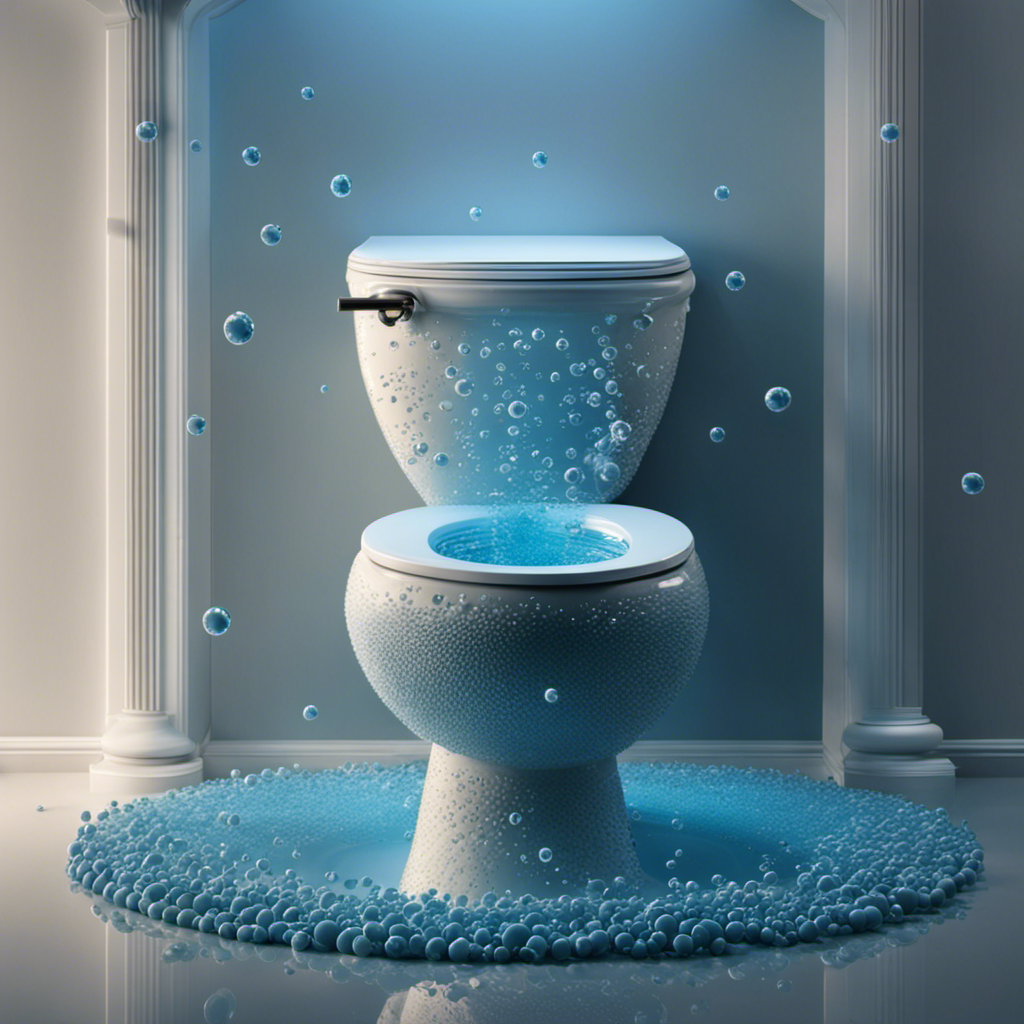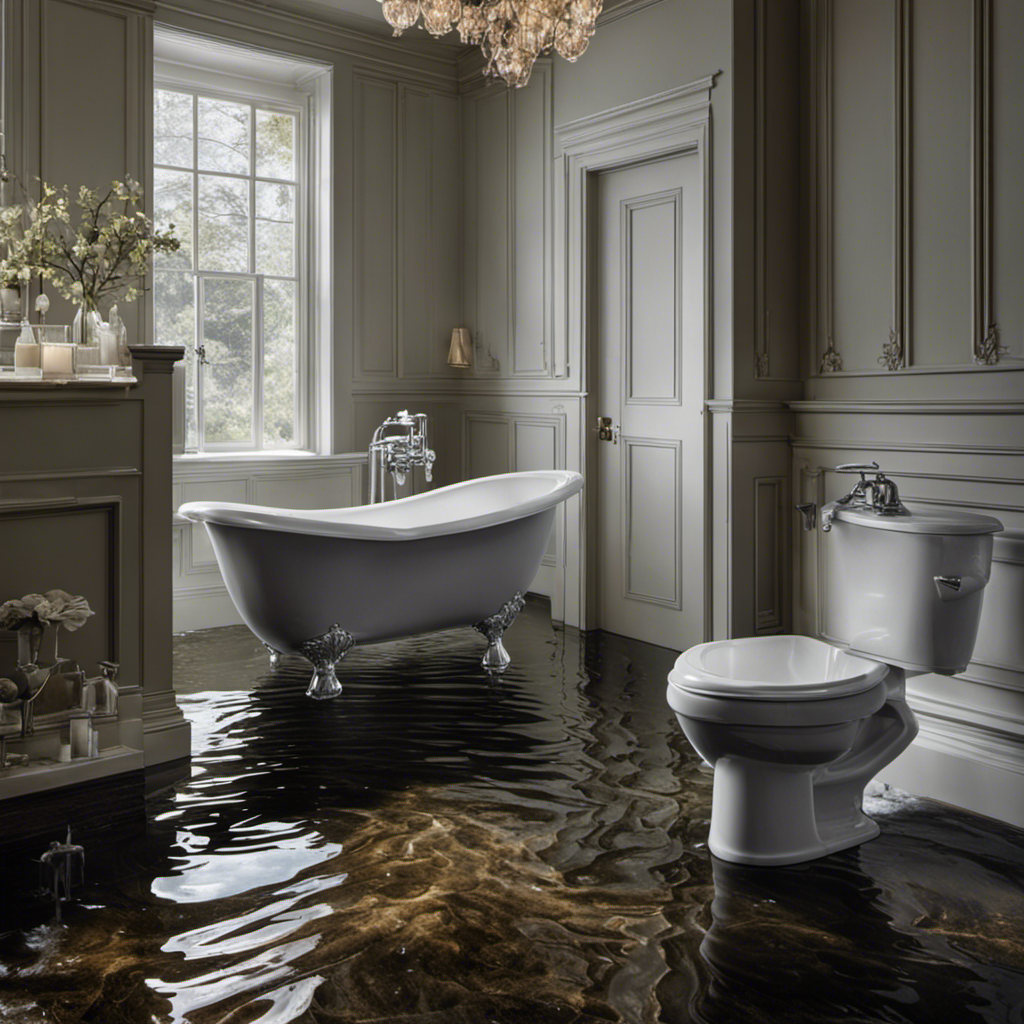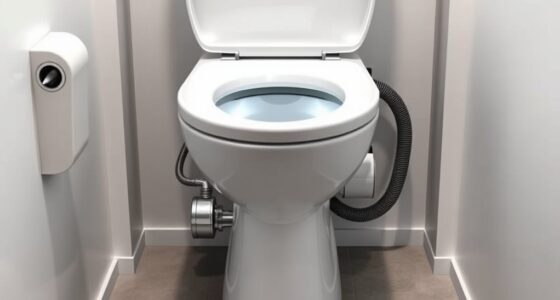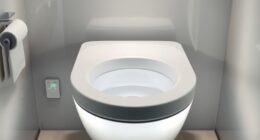Have you ever wondered why your toilet bubbles? It’s a common problem that can be both frustrating and mysterious.
In this article, I will delve into the science behind toilet bubbles and provide you with the common causes and solutions.
Imagine this scenario: you flush your toilet and suddenly, it starts bubbling furiously. What could be causing this?
Stay tuned as I uncover the secrets behind this phenomenon and offer expert advice on how to prevent and troubleshoot toilet bubbles.
Key Takeaways
- Toilet bubbles are caused by a vortex created when water rushes into the bowl, creating a low-pressure area that pulls air down with it.
- The Bernoulli principle and the Venturi effect play a role in the formation of toilet bubbles, as increased fluid velocity leads to decreased pressure and suction force.
- Common causes of toilet bubbling include clogged sewer lines, blocked vent pipes, and poor air balance in the plumbing system.
- To prevent toilet bubbles, regular cleaning and maintenance of the plumbing system, keeping the vent stack clear, and installing backflow prevention devices are recommended.
The Science Behind Toilet Bubbles
The science behind why a toilet bubbles is still not fully understood. However, there are some theories that explain the toilet bubble formation.
When a toilet is flushed, water rushes into the bowl and creates a vortex. This vortex creates a low-pressure area in the center of the bowl, pulling air down with it. As the water level rises, the air gets trapped in the water and forms bubbles.
The physics behind toilet bubbles is related to the Bernoulli principle and the Venturi effect. The Bernoulli principle states that as the velocity of a fluid increases, the pressure decreases, creating a suction force. The Venturi effect occurs when a fluid flows through a narrow passage, causing its speed to increase and pressure to decrease. Both these principles contribute to the formation of toilet bubbles.
However, further research is needed to fully understand the complex dynamics involved in this phenomenon.
Common Causes of Toilet Bubbling
If your toilet is bubbling, it could be caused by a clog in the plumbing. Toilet bubbles occur when there is a blockage in the pipes, preventing proper water flow.
One common cause of toilet bubbling is a clogged sewer line, which can result from accumulated debris or tree roots invading the pipes. Another culprit could be a blocked vent pipe, which disrupts the air balance in the plumbing system.
Signs of toilet bubbling include gurgling noises, slow drainage, or even sewage backup. It is essential to address these issues promptly to prevent further damage to your plumbing system and potential health hazards.
How to Prevent Toilet Bubbles
To prevent toilet bubbling, you should regularly clean your plumbing system to avoid clogs and blockages. By keeping your pipes clear of debris and buildup, you can minimize the risk of air pockets forming and causing bubbles in your toilet.
In addition to regular cleaning, there are a few other toilet bubble prevention techniques you can try. First, make sure your vent stack is clear and free from any obstructions. The vent stack allows air to flow through the plumbing system, preventing air pressure imbalances that can lead to bubbles.
Another DIY solution for toilet bubbles is to install a backflow prevention device. This device prevents wastewater from flowing back into your plumbing system, which can cause bubbles and other issues.
Troubleshooting Toilet Bubbles
One possible solution for troubleshooting toilet bubbles is checking the water level in the tank. Here are four causes of toilet bubbles and how to fix them:
-
Low water level: If the water level in the tank is too low, it can cause bubbles. To fix this, adjust the fill valve or float to ensure the water level is at the recommended mark.
-
Clogs in the drain pipe: A clog in the drain pipe can cause air to get trapped and result in bubbles. Use a plunger or a drain snake to clear the clog and restore proper drainage.
-
Ventilation issues: Poor ventilation can cause air pressure imbalances and lead to toilet bubbles. Check the vent pipes for blockages and clean them if necessary.
-
Faulty fill valve: A faulty fill valve can cause water to enter the tank too quickly, creating bubbles. Replace the fill valve to resolve this issue.
Plumbing Tips for Dealing With Toilet Bubbles
By addressing these common causes, you can effectively resolve the issue of toilet bubbles and ensure proper functioning of your plumbing system.
When dealing with toilet bubbles, there are a few DIY solutions you can try before calling a professional plumber. One common cause of toilet bubbles is a clogged vent pipe. To remedy this, you can try using a plumbing snake to clear any obstruction in the pipe.
Another possible cause is a blocked sewer line, which can be resolved by using a sewer auger to remove the blockage. Additionally, a malfunctioning toilet fill valve can cause bubbles. In this case, replacing the fill valve should solve the problem.
Frequently Asked Questions
Can Toilet Bubbles Cause Any Damage to the Plumbing System?
Toilet bubbles, if left unchecked, can potentially cause damage to the plumbing system. Prevention is key. Understanding the causes of toilet bubbles, such as clogs or a malfunctioning flapper, can help avoid any potential plumbing issues.
Are Toilet Bubbles More Common in Certain Types of Toilets?
Toilet bubbles can occur in any type of toilet, but certain factors can make them more common. It’s important to understand toilet bubble prevention techniques, as well as the factors that affect their occurrence.
Can Toilet Bubbles Be a Sign of a Larger Plumbing Issue?
Toilet bubbles can indicate a larger plumbing issue. Possible causes include a clogged vent stack or sewer line. Troubleshooting tips include checking for blockages, ensuring proper venting, and consulting a professional if needed.
Do Toilet Bubbles Indicate a Problem With the Sewage System?
Toilet bubbles can be a sign of a problem with the sewage system. Common causes include clogs, sewer line issues, or a malfunctioning vent pipe. To prevent toilet bubbles, ensure proper plumbing maintenance and avoid flushing non-flushable items.
Are There Any Health Risks Associated With Toilet Bubbles?
Health implications of toilet bubbles can include the release of harmful gases and bacteria, leading to respiratory issues and infections. Prevention measures involve regular cleaning and maintenance of the sewage system, as well as proper ventilation.
Conclusion
In conclusion, the phenomenon of toilet bubbling is a common plumbing issue that can be caused by a variety of factors. Understanding the science behind toilet bubbles and implementing preventive measures can help maintain a smooth and efficient plumbing system.
By troubleshooting and following some handy plumbing tips, you can effectively deal with toilet bubbles and ensure a hassle-free bathroom experience. So, next time you hear that familiar gurgle, remember to apply these techniques and keep your toilet bubbling-free.









